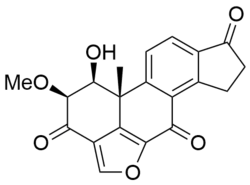Viridin
Viridin is an antifungal metabolite of Gliocladium virens that was first reported in 1945.[1] Belonging to a class of molecules known as furanosteroids, it has a characteristic highly strained electrophilic furan ring fused between C-4 and C-6 of the steroid framework. Members of this family, including wortmannin, are known to be potent, irreversible covalent inhibitors of phosphoinositide 3-kinases (PI3Ks).[2]
 | |
| Names | |
|---|---|
| IUPAC name
(1S,2S,11bR)-1-Hydroxy-2-methoxy-11b-methyl-1,7,8,11b-tetrahydrocyclopenta[7,8]phenanthro[10,1-bc]furan-3,6,9(2H)-trione | |
| Identifiers | |
3D model (JSmol) |
|
| ChemSpider | |
| ECHA InfoCard | 100.019.989 |
| UNII | |
CompTox Dashboard (EPA) |
|
| |
| |
| Properties | |
| C20H16O6 | |
| Molar mass | 352.337 g mol−1 |
Except where otherwise noted, data are given for materials in their standard state (at 25 °C [77 °F], 100 kPa). | |
| Infobox references | |
Biosynthesis
The complete biosynthesis of viridin is not known. Through [2-14C]mevalonic acid labeling studies, it has been shown that viridin is biosynthesized from a triterpenoid pathway, which starts from squalene, rather than a diterpenoid pathway.[3] Incorporation of lanosterol into viridin has been described.[4] Although the mechanisms and order of the remaining steps from lanosterol to viridin are not certain, these include the formation of the furan ring, the loss of C-13 and C-14 methyl groups, aromatization of the C-ring, removal of the side chain, and oxidation of the A-ring. Some of these steps may be analogous to pathways of other steroids. Loss of a hydrogen atom from C-15 during removal of the C-14 methyl group suggests a pathway similar to that of other steroid biosyntheses.[5] Analogous to the cholesterol pathway, the C-14 methyl group is lost as formic acid by action of sterol 14-demethylase.[6] Though the C-13 methyl group isn't removed in the pathway of aldosterone, it is possible that viridin undergoes analogous oxidation at C-18 followed by loss of formic acid or decarboxylation to remove the C-13 methyl. Removal of the side chain has been shown to follow a mammalian pathway.[7] It likely follows the pathway of androstenedione and oxidatively removes the side chain as acetic acid, resulting in a ketone on the D-ring.[6] The “extra” carbon in the furan ring at C-4 comes from the 3’-position of mevalonic acid and represents the C-4β-methyl group of lanosterol.[5] Oxidation and decarboxylation of the C-4α-methyl group is consistent with the normal mammalian steroid pathway; however, instead of repeating these steps to remove the other methyl group, the second oxidized methyl group is likely intercepted to form the furan ring by an unknown mechanism. Studies show that aromatization of the C-ring proceeds without skeletal rearrangement.[5]
In the biosynthesis of viridiol by Gliocladium deliquescens, the 3β-OH reduced form of viridin, the incorporation of squalene, lanosterol, dehydroxydemethoxyviridin, and demethoxyviridin was reported.[8][9] This suggests that the vicinal oxygenations at C-1 and C-2 are independent steps involving hydroxylation.




References
- BRIAN, P. W.; MCGOWAN, J. G. (4 August 1945). "Viridin: a Highly Fungistatic Substance Produced by Trichoderma viride". Nature. 156 (3953): 144–145. doi:10.1038/156144a0.
- Yano, H; Nakanishi, S; Kimura, K; Hanai, N; Saitoh, Y; Fukui, Y; Nonomura, Y; Matsuda, Y (Dec 5, 1993). "Inhibition of histamine secretion by wortmannin through the blockade of phosphatidylinositol 3-kinase in RBL-2H3 cells". The Journal of Biological Chemistry. 268 (34): 25846–56. PMID 7503989.
- Blight, Margaret M.; Coppen, J. J. W.; Grove, John Frederick. "The biogenesis, from mevalonic acid, of the steroidal antifungal metabolite viridin". Chemical Communications (London) (18): 1117. doi:10.1039/C19680001117.
- Golder, Walter S.; Watson, Thomas R. "Lanosterol derivatives as precursors in the biosynthesis of viridin. Part 1". Journal of the Chemical Society, Perkin Transactions 1: 422. doi:10.1039/P19800000422.
- Hanson, James R.; O'Leary, Margaret A.; Wadsworth, Harry J. "Studies in terpenoid biosynthesis. Part 28. The acetate and mevalonate labelling patterns of the steroid, demethoxyviridin". Journal of the Chemical Society, Perkin Transactions 1: 867. doi:10.1039/P19830000867.
- Dewick, Paul M. (2009). Medicinal natural products : a biosynthetic approach (3rd ed.). Chichester: A John Wiley & Sons. ISBN 978-0-470-74167-2.
- Hanson, James R.; O'Leary, Margaret A.; Wadsworth, Harry J. "Fungal cleavage of the sterol side chain". Journal of the Chemical Society, Chemical Communications (18): 853. doi:10.1039/C39800000853.
- Hanson, James R.; O'leary, Margaret A.; Wadsworth, Harry J.; boon, leng yeoh. "The biosynthesis of the steroid, viridiol, by Gliocladium deliquescens". Phytochemistry. 27 (2): 387–389. doi:10.1016/0031-9422(88)83104-2.
- Jones, Richard (1987). "Conversion of viridin to viridiol by viridin-producing fungi". Canadian Journal of Microbiology. 33 (11): 963–966. doi:10.1139/m87-169.